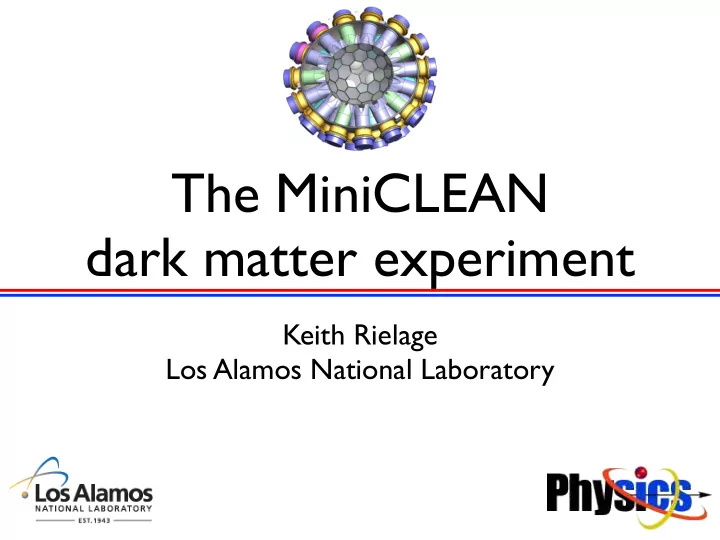

The MiniCLEAN dark matter experiment Keith Rielage Los Alamos National Laboratory
Single-phase Noble Liquid Electronic recoil (gamma) PMT pulses in LAr Nuclear recoil (neutron) • Noble liquids have singlet and triplet excited states • For argon and neon, decay times for these states are different and long enough to provide discrimination between electronic and nuclear recoils • Electronic recoils result in more triplet states so more late light
Discrimination • Ratio of early to late light discriminates between types of recoils • 1 part in 10 15 of argon is 39 Ar which beta decays so need rejection of electronic recoils better than 10 9 • R&D shows rejection is achievable
Conceptually Simple Detector • Sphere of argon or neon serves as target for WIMPs • Scintillation light from recoils Lightguide at 80-128 nm & PMT • Converted to visible by wavelength shifter on acrylic • Light guide brings visible light LAr to photomultiplier tube where signal recorded Wavelength Shifter
MiniCLEAN Detector • Liquid cryogen can be argon or neon • ~150 kg fiducial volume • PMTs - Hamamatsu R5912-02MOD operating in cryogenic liquid • Cryogen, PMTs and wavelength shifters contained in stainless steel Inner Vessel (IV) • IV is surrounded by stainless steel Outer Vessel with vacuum insulation and thermal blanket • PMT and wavelength shifter (TPB) on acrylic plate are part of modular optical cassette • 92 optical cassettes
MiniCLEAN detector Outer Vessel LAr/ LNe Inner Vessel PMT Courtesy J. Griego
Optical Cassette Top Hat PMT Light Guide Acrylic Plate
MiniCLEAN - Outer Vessel & Shield Deck Outer Vessel Water Shield Inner Tank O Vessel Ves Courtesy J. Griego
Target Exchange 8
Outer Vessel Manufacturing Courtesy F. Lopez
Inner Vessel Progress • Stainless steel hemispheres made by Trinity Heads, Inc in Texas • Fabrication started at Winchester Precision Technologies Courtesy F. Lopez
Inner Vessel Progress • Stainless steel hemispheres made by Trinity Heads, Inc in Texas • Fabrication started at Winchester Precision Technologies Courtesy F. Lopez
Inner Vessel Progress • Stainless steel hemispheres made by Trinity Heads, Inc in Texas • Fabrication started at Winchester Precision Technologies Courtesy F. Lopez
Inner Vessel Progress • Stainless steel hemispheres made by Trinity Heads, Inc in Texas • Fabrication started at Winchester Precision Technologies Courtesy F. Lopez
SNOLAB Surface Facility 2 km of rock Underground Laboratory
SNOLAB Cube Hall Cryopit Utility Phase III Drift Stub Ladder Labs SNO South Cavern Drift Personnel facilities Utility Area
SNOLAB Cube Hall Cryopit Utility Phase III Drift Stub Ladder Labs SNO South Cavern Drift Personnel facilities Utility Area
SNOLAB Cube Hall Cryopit Utility Phase III Drift Stub Ladder Labs SNO South Cavern Drift Personnel facilities Utility Area
Courtesy F. Duncan
Insert Detector Here Courtesy F. Duncan
The DEAP and CLEAN Family of Detectors DEAP-0: picoCLEAN: Initial R&D detector Initial R&D detector DEAP-1: microCLEAN: 7 kg LAr 4 kg LAr or LNe 10 -44 cm 2 2 warm PMTs 2 cold PMTs At SNOLab 2008 surface tests at Yale MiniCLEAN: 500 kg LAr or LNe (150 kg fiducial mass) 10 -45 cm 2 92 cold PMTs DEAP-3600: At SNOLAB mid-2011 3600 kg LAr (1000 kg fiducial mass) 10 -46 cm 2 266 warm PMTs At SNOLAB 2012 WIMP σ Sensitivity 50-tonne LNe/LAr Detector: pp-solar ν , supernova ν , dark matter <10 -46 cm 2 At DUSEL ~2016?
Sensitivity -42 10 Cross-section [cm 2 ] (normalised to nucleon) XENON10 (2007) !"#$%&'(')*'+,'('-.' CDMS (2008) -43 10 -44 10 MiniCLEAN !"#$%&'(')**'+,'('-.' LUX -45 10 CLEAN, Ne CLEAN, natural Ar -46 10 !"#$%&'(')***'+,'('-.' CLEAN, depleted Ar -47 10 1 2 3 10 10 10 WIMP Mass [GeV/c 2 ]
Current Schedule • OV will be underground by end of year in tank with stand • Underground infrastructure (utilities, deck, water tank) ready in September • Subsystem commissioning in early 2011 • IV scheduled for completion in May 2011 • Assembly scheduled for Summer 2011 • Full commissioning in Fall 2011 • Liquid argon dark matter run by end of 2011
Overarching Goals of MiniCLEAN Technical Proof-of-Principle We aim to demonstrate all salient features of a 4 π single-phase detector using, interchangeably, targets of LAr and LNe. Analysis Philosophy Using our experiences from SNO, SK etc … we aim to develop a robust analysis program where all detector parameters and response to signal and backgrounds are over-constrained through simulation and calibration. Dark Matter Search Perform a search for WIMP dark matter with a sensitivity competitive and complementary to next generation experiments with order 100 kg fiducial mass. Future MiniCLEAN serves as a prototype to a full-scale (~50T) CLEAN.
DEAP/CLEAN Collaborators University of Alberta University of North Carolina/TUNL B. Beltran, P . Gorel, A. Hallin, S. Liu, C. Ng, K.S. Olsen, J. Soukup M. Akashi-Ronquest, R. Henning Boston University University of Pennsylvania D. Gastler, E. Kearns T. Caldwell, J.R. Klein, A. Mastbaum, G.D. Orebi Gann Carleton University Queen’s University M. Bowcock, K. Graham, P . Gravelle, C. Oullet M. Boulay, B. Cai, M. Chen, S. Florian, R. Gagnon, V. Golovko, P . Harvey, M. Kuzniak, J. Lidgard, A. McDonald, T. Noble, Harvard University P . Pasuthip, C. Pollman, W. Rau, P . Skensved, T. Sonley, M. Ward J. Doyle SNOLAB Institute Los Alamos National Laboratory M. Batygov, F.A. Duncan, I. Lawson, O. Li, P . Liimatainen, K. Bingham, R. Bourque, V.M. Gehman, J. Griego, R. Hennings- K. McFarlane, T. O’Malley, E. Vazquez-Jauregi Yeomans, A. Hime, F. Lopez, J. Oertel, K. Rielage, L. Rodriguez, University of South Dakota S. Seibert, D. Steele V. Guiseppe, D.-M. Mei, G. Perumpilly, C. Zhang Massachusetts Institute of Technology Syracuse University L. Feng, J.A. Formaggio, S. Jaditz, J. Kelsey, J. Monroe, K. Palladino M.S. Kos, R.W. Schnee, B. Wang National Institute Standards and Technology TRIUMF K. Coakley P .-A. Amaudruz, A. Muir, F. Retiere University of New Mexico Yale University M. Bodmer, F. Giuliani, M. Gold, D. Loomba, J. Matthews, P . Palni W.H. Lippincott, D.N. McKinsey, J.A. Nikkel, Y. Shin
Recommend
More recommend